Headband Repair Samsung Level On Pro
- Tutorial
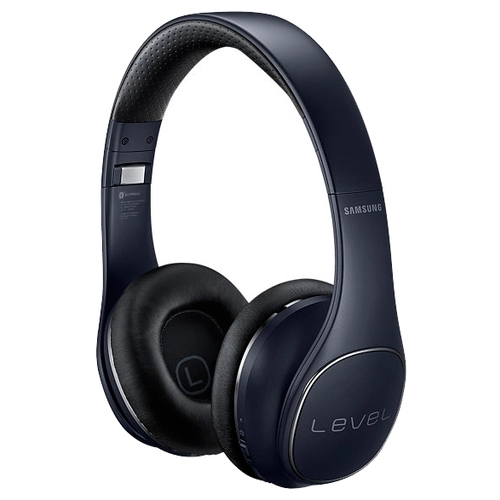
I got on occasion the Samsung Level On Pro EO PN920 headphones with bluetooth. Headphones pleased me for exactly 5 months, after which it seemed to me that they started somehow not very well kept on their heads. A quick inspection showed that there were cracks along the headband, many cracks, I would even say disastrously much. The operation was exclusively homely and very careful, I did not drag the headphones around the city, and I can say it blew the dust off them, since I treat any equipment carefully.
Disclamer: I won’t touch upon the issue of sound quality, are they worth repairing or not, or you had to go and buy new ones, the correct vendor, who knows a lot about headphones. I decided to fix it, and do it so that the final result looked acceptable and, if possible, maintain the folding functionality. I also note that at the beginning of the repair I did not plan an article, because I didn’t take so many photos of the repair process itself, but everything there just believe me, everyone is sure to handle it.
We disassemble the headphones, unscrew from the inside of the headband 2 small screws with a Torx T5 screwdriver on each side, remove the covers, then gently pry a thin screwdriver to separate the soft inner cover with "eco skin". Below in the photo you can see the quality of the skin of a young dermatin, (by the way, I got these):
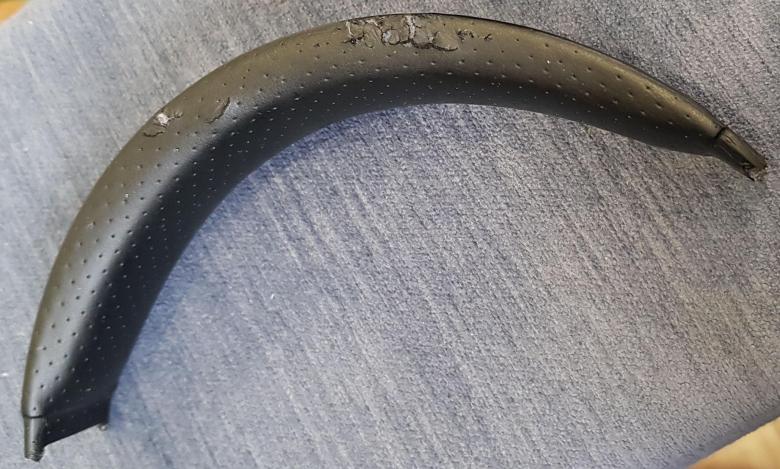
We shift the remaining U-shaped pad in the direction from the ear cushion, it is advisable to use hands or a rubberized part of a screwdriver for this, as can damage this delicate plastic. We also remove the stoppers of each earphone, they are simply pulled out on themselves.
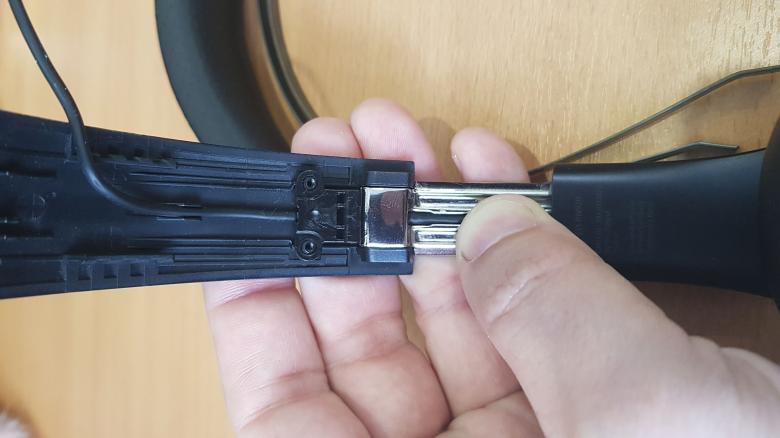
After that, we squeeze the pin of the hinge of the earphone itself with a thin screwdriver and here is the headband in our hands:

Actually the problem itself:

At this stage I went google, it became clear that I definitely should not be alone in this problem. Indeed, the problem with cracking the headband is quite widespread, many people are faced with this, even breaking into pieces, and on well-known classified sites they even offer repair of this particular model. On the Internet, I found such a repair option.. I definitely won’t do that. Finally I went to aliexpress, hoping to find a new headband, but unfortunately they only offer ear pads, and most of them have just complete order. So we will repair it on our own.
It became clear that the headband needs to be strengthened somehow. I went to the local market for a women's jewelry store, bought cheaply two female iron rims, one turned out to be 5mm wide, the other 7mm, laid out all the spare parts on the table:

They fit well in shape, and after 20 minutes of straightening with my hands, they came up almost perfectly. Trying on:

Here I must say that there are two repair options, either to strengthen the headband on the outside, which seemed to me more correct, but it will require skin tightening, or to glue the iron rim inside, which eliminates the need to work with the skin, but does not save the ends of the headband from breaking off where the hinges are on which the headphones themselves are held. It can be seen that the cracks have already gone behind the hinges, and the iron rim can no longer be glued in there, since the headphone stopper will interfere.

We measure the rim, trim the excess, apply to the headband

We attach it with tape, partially collect the headphones to check the clamping force of the resulting structure. If everything suits (and I was satisfied with the 7mm rim), then we disassemble it back, press the rim and draw the lines along the contour of the rim with an awl to precisely fit it to your seat and subsequently precisely combine the two parts. The bezel is one, that the second one was not in perfect shape, therefore stood on the headband with a certain bevel, but only in this position did it press all the way to the headband

I decided to glue the bezel on the 88th glue, because firstly it does not tan after solidification, and secondly it is very durable and easy to buy. In order for the glue to have better adhesion, the gluing points must be sanded, made rough (yes, the first time I did not sanded and I had to clean all the glue). I used the usual sandpaper for the rim and files for the headband. We glue the bezel in accordance with the instructions for the glue, with the obligatory degreasing and aging in time. Next, you need to press the rim along the entire length of the headband, here I puzzled for a long time how to do this without damaging the already rather fragile headband. A good option turned out to be clamp clamps of such a plan
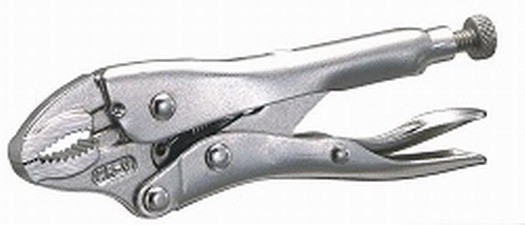
It is necessary to adjust the pliers so that they are pressed well, without breaking plastic. After connecting the headband and the rim, you need to go through this clamp along the entire length of the rim, the rim is pressed, squeezing the glue, wait 30-60 seconds and move to the next section, and after that it will not be torn off. After pressing along the entire length, I fixed the pincers at both ends of the resulting structure and left it until the glue completely dried. Instead of ticks, I think you can pick up small clamps.
At this point, I still decided to glue the old cracks, I thought for a long time what, but I didn’t come up with it, we glue one crack immediately, a new one is formed in another place. I read a series of articles on adhesives and plastics from the respected steanlaband I realized that it would be difficult to find the right glue that was infinitely far from chemistry anyway, but it’s better not to come close to dichloroethane. Therefore, without further ado, cunningly walked the usual cyanoacrylate through all the cracks and that’s it. But how to protect yourself from future cracks? I looked at the glue gun and thought that it was quite an option as a binder. So that the newly formed cracks do not begin to walk along their entire length, you need to fill in the remaining space on both sides of the rim with conventional hot-melt adhesive.

After applying a stain of 1.5 cm of glue, I press and smooth it with glossy paper - a substrate from various kinds of stickers, it does not stick to the hot glue.
Next, I needed skin, I ordered a skin section for aliexpress as soon as I decided to repair the headband, and after 2 weeks I already had a skin section of about 30x30 cm. He took the thinnest skin he could find - 0.3-0.5 mm, as it stretches better and is easier to shape. I must say that before that I did not work with the skin and this was my first experience. In fact, the skin bought at random. Already after the headphones were ready, I found out that in Moscow you can buy leather of much better quality and at the same time cheaper. Therefore, I don’t see much point in ordering to order blindly on aliexpress; it’s easier to come to the store and touch all the options with your hands and choose the most suitable one. Life hack - a small piece of glove leather can be bought in all kinds of “shoe repairs”, “mending clothes” and so on. my skin is more suitable for the definition of salon - for tightening car interiors.
Skin-tight began with a soft bottom. We remove the dermatin with improvised means.

It is glued to some not very good rubber glue, it peels off easily.
Straighten the peeled-off piece of dermatine, smooth it and glue it with transparent adhesive tape to the skin on the back side and cut it out according to the resulting template with a small margin of 1-2 mm, I did not follow exactly all the cutouts of the template, this is useless, the edges will be hidden behind the overlays. So that the skin does not leave wrinkles, you need to start gluing on one side while pulling the skin along the edge, then move to the other side and also glue in a stretch. Glue only the same bead that was glued to the original dermatin. The skin does not stick to the foam. I used glue like this:
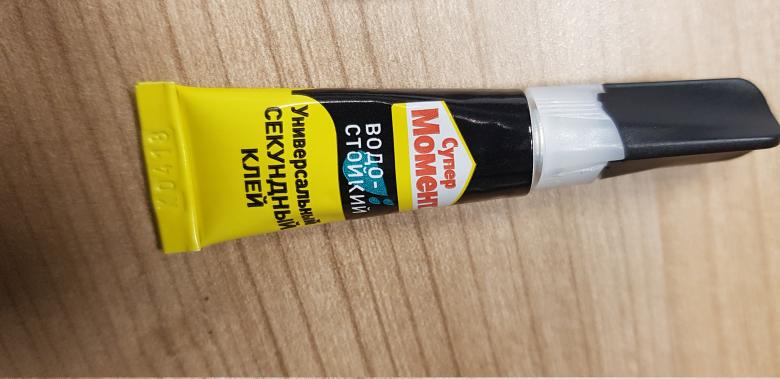
Why this glue? It has several parameters that are very important for this work. It does not leave whitish streaks, hardens rather quickly, while having a margin of time of 5-10 seconds before joining the surfaces and after solidification it is completely transparent and not fragile like ordinary cyanoacrylate. In pluses, unlike the latter, it does not have superfluidity and can be applied quite accurately to a thin edge of 2 mm. I smeared areas of 2 cm and glued the skin with my fingers, held in place for a minute and glued the next area. The biggest danger here is to glue an open area of skin with glue, so if the glue comes out somewhere, and you want to be more comfortable, it’s better not to, or keep in mind that you can stain the skin.
After gluing, it turned out like this:

It can be seen that there are small folds - it was necessary to better and more evenly stretch the skin during sizing, and also take into account that the skin stretches differently in the longitudinal and transverse directions and the template should be positioned correctly, and not in order to save skin, as it happened in my case. But in principle, for the first time, and I think it turned out quite normal, the folds look natural.
Getting to the headband. After tightening the headband, it will increase in size by the thickness of the skin and the soft inner part may not fasten into its latches. Therefore, you need to take a sharp clerical knife and remove the shoulder along the edges of the headband flush with the main, as well as from the ends, where the overlap in 2-3 mm of skin will go. You can accurately measure the height of the material being removed from the ends with a caliper, my skin thickness was 0.5 mm, I added 0.1 mm to the glue, so I removed 0.6 mm from each side, it turned out perfectly. At this point, I had to dremel to remove some material from the iron rim, while at the same time rounding its edge. Therefore, you can immediately measure the rim 0.5mm shorter on each side. With a stationery knife, the plastic is removed without problems, the main thing is not to rush and act carefully without forgetting about the safety of your own hands.

Next, I took the skin, at this point I realized that it stretches in each direction in different ways. I put the headband on the skin in the direction where it stretches better and drew a template, leaving a margin on each side of about 5 mm, this is more than enough. According to experience at the ends, the margin can be left at 1-2 mm, my skin stretched very easily and very strongly, so that from a margin of 1 cm by the sum of the sides it turned out to be too much, then just cut off the excess.
First we glue one end, after a couple of minutes the glue will already set and you can stretch the skin along the entire length. smearing the second end of the headband with glue, I pulled the skin as tight as possible and glued it. I cut it to size after gluing, which was not very convenient. I think it’s better to measure right away, take a margin of 3-5 mm from the maximum stretch and evenly trim the edge and glue it along the even edge, or have thin manicure scissors. Well, then we tighten the sides and glue them 2-3 cm.

The final result is gluing the headband with leather.
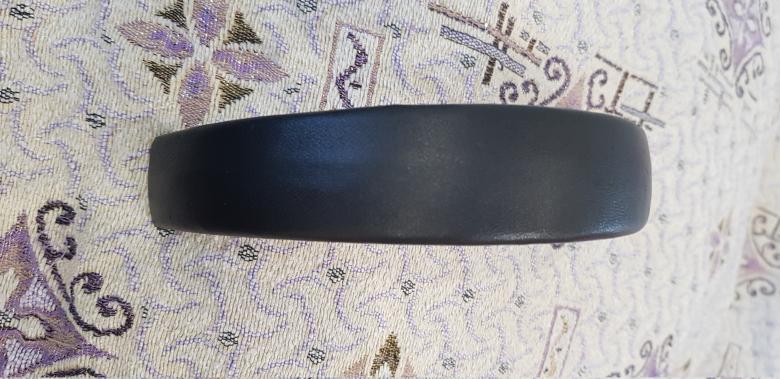
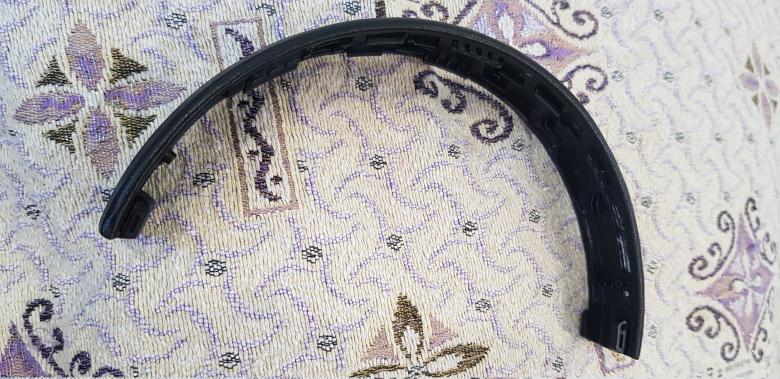
Well, then it remains to collect everything. There were no problems with the assembly. Everything clearly fell into place.
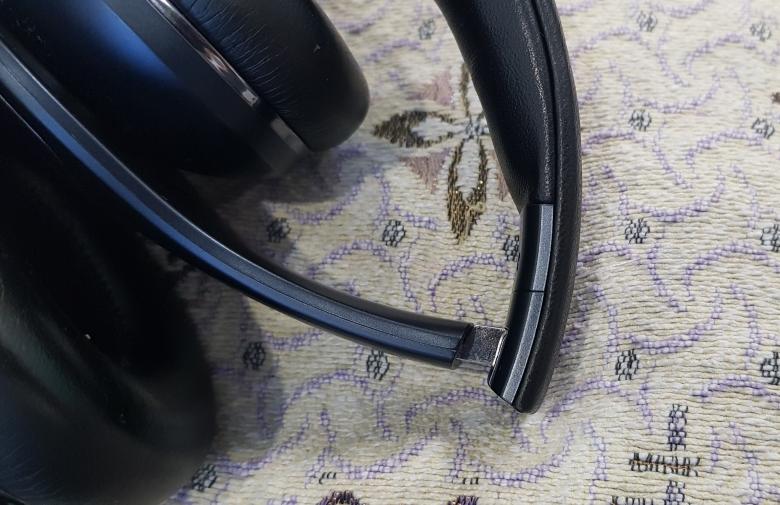




The result completely satisfied me, the headphones have a neat appearance, they sit perfectly on the head and do not fall off, and I hope they will last a long time. The repair budget amounted to about 700r, and the remainder of the skin will definitely find application. The main rule that helped me was not to rush, to do everything slowly, for my pleasure.
PS: This is my pilot article on Habr, I ask you not to kick much.
